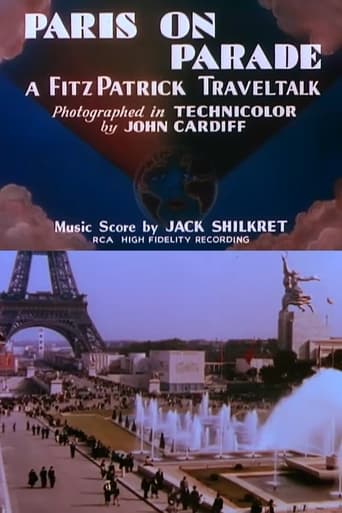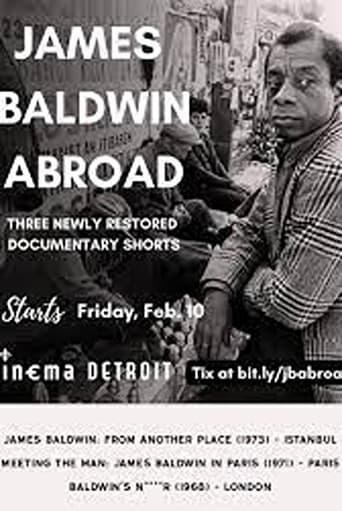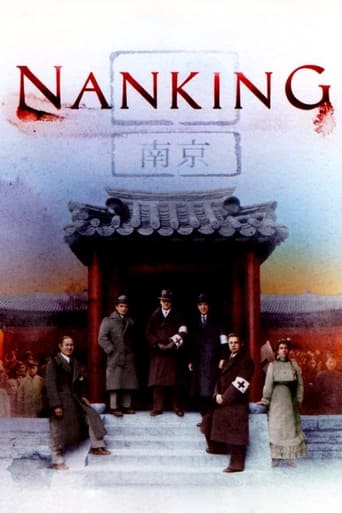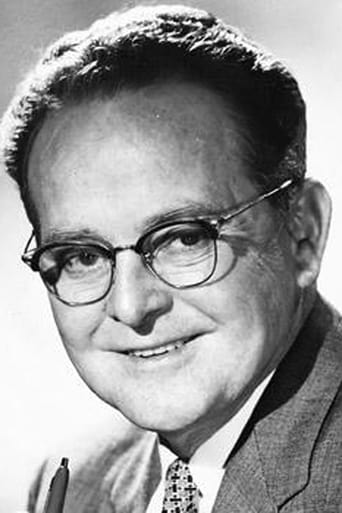
This Traveltalks short showcases the Paris International Exposition of 1937. It features a tour of the pavillions of several nations, as well as the spectacular water and light displays.
Similar titles




Reviews
Best movie of this year hands down!
Touches You
This is a small, humorous movie in some ways, but it has a huge heart. What a nice experience.
The film's masterful storytelling did its job. The message was clear. No need to overdo.
Like the 1937 travelogue on Czechoslovakia, this one has profound interest for the historian. When I think what horrors all of these people would soon be cast into....The other aspect of historical interest is the colonial exhibits. Of course after the war the colonies would start the long process of breaking away from their colonizers.The architecture of each nation is another facet that might make someone want to watch. It shows the thinking of various nations toward their environment as reflective of their culture, except of course for the colonial exhibits which were basically the colonizers showing native housing as interpreted by outsiders for outsiders. We have no way of knowing what, for instance, a creative architect in SE Asia might have thought up for this exposition. Egypt's pavilion was a take on traditional architecture. Czechoslovakia went in for something that the Jetsons would appreciate. The Norwegians preferred to bring to mind their fjords and water. Hungarians danced, perhaps wondering what they would face when they went home. They might not have gone home if they had known of the decades of rape, pillaging, and murder at the hands of one fiend after another that were to come.I thought Russia's gigantic sculptures on top of the massive building were meant to intimidate and apparently that was the case. I didn't see the German pavilion. Apparently it was opposite the Russian and they had a war of ideology going on. Germany's was topped by an eagle and swastika and had had a statue of two nude men. Russia's pavilion had a man and woman. All in very heroic-type poses as advertising for their country's and system's superiority over all others but especially over their rival across the way, totally against the peaceful theme of this travelogue or indeed of the exposition. I also read that the Spanish pavilion had Guernica on display.Everything was accompanied by the usual music to represent each part of the world.There are websites that talk about this exposition, what it wanted to achieve, and the other exhibitors not mentioned in the travelogue. Obviously one goal of the Depression era expos was to boost tourism and trade. But the specific goal of this one had a decidedly anti-war aspect to it that was promoted by the narrator of the travelogue. It is debatable if ANY of the Thirties expos achieved its goals but as my dearly departed mother used to say, they made a lot of work for a lot of people. And in the Thirties, that made a welcome change.
Paris on Parade (1938) *** (out of 4) One of the better entries in James A. FitzPatrick's TravelTalks series visits Paris during the 1937 Paris International Exposition. According to this short there were forty-four different nations displaying various forms of their country here and being able to see just a few are a real treat. I'd be lying if I said I had previously heard about this event but that's what makes some of these shorts so much fun. The entire short didn't really show off the city, like so many in the series, but instead just looked at this event, which had some great displays including works from Africa, Sudan, France and many others. Just seeing how different these places were, side by side, is what makes this short such a winner.
Ironically, the theme for the Paris Exposition was "The Spirit of Peace", just as World War II was looming across many European countries, including France and the city of light.This is a rather by-the-numbers dry view of various pavilions, all of which are glanced from outside only with no indication of what the buildings held inside. The usual commentary is spoken by James FitzPatrick in a dull monotone.At least we're told that the flags of 44 nations are displayed along the banks of the Seine where the Eiffel Tower is part of the exhibition; countries included Great Britain and its Empire, Sweden (simplicity), Czechoslovakia (impressive architecture), U.S. (American Indian displays), France (replica of Statue of Liberty and French colonies, a pavilion of French-IndoChina and colonies of French West Africa), a shot of a water skier on the Seine, and a Russian statue of heroic figures situated atop a monument 100 ft. high.At the Spanish pavilion we see dancers from Segovia; and toward the closing we see The Fountain of Peace, an aquatic display of the kind France is noted for. The final shot are the illuminated fountains at night in brilliant color (thanks to electricity) and the short documentary ends with a pyrotechnical display of fireworks, the very same kind that would light up New York's World Fair a few years later.Interesting but none of the pavilions looked that impressive to me. Might have been more interesting to show some of the interior displays, but I suppose time would not allow that.Sad to realize that the theme of peace was an ironic one, considering all that was soon to follow.
An MGM TRAVELTALK Short Subject.PARIS ON PARADE takes us on a dazzling exterior tour of the pavilions built for the 1937 Paris Exposition. The film ends with the wonderful waterworks & pyrotechnic display on and over the River Seine.This is one of a large series of succinct travelogues turned out by MGM, beginning in the 1930's. They featured Technicolor views of beautiful & unusual sights around the globe, as well as vivid, concise commentary. These films were produced & narrated by James A. FitzPatrick.
Top Streaming Movies













